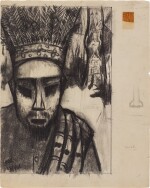
Uche Okeke
Egbenuoba, A Collection of Five Drawings
Lot Closed
March 22, 04:10 PM GMT
Estimate
4,000 - 6,000 GBP
Lot Details
Description
Uche Okeke
Nigerian
1933-2016
Egbenuoba, A Collection of Five Drawings
I.
Egbenuoba
signed and dated 18/1/61 (lower left); titled and inscribed Zaria 1961 (on the reverse)
charcoal on paper
25.7 by 20.7cm., 10 by 8in.
II.
Head with Horn
signed and dated 1962 (lower right); titled and dated (on the reverse)
charcoal on paper
45.5 by 32cm., 18 by 12½in.
III.
Design for a Wrought Iron Work
signed and dated 1959 (lower right); titled (on the reverse)
pen on paper
17.5 by 14cm., 6¾ by 5½in.
IV.
Untitled
signed and dated September 1961 (lower left)
charcoal on paper
9.5 by 21.5cm., 3¾ by 8½in.
V.
Mansion in the Village
signed and dated 1966 (lower right); titled and inscribed Social 39 (on the reverse)
pen on paper
17 by 10.3cm., 6¾ by 4in.
Collection of Uche Okeke (1933–2016)
Acquired from the above by the present owner
Uche Okeke, Art in Development - A Nigerian Perspective, Bayreuth 2019, 'Mansion in the Village' illustrated p. 135 cat. no. 60
Egbenuoba is a preparatory study for the 1961 oil painting of the same name in the collection of the National Council for Arts and Culture, Abuja, and illustrated in Chika Okeke-Agulu's Postcolonial Modernism (2015, fig. 3.7). Complete with the artist's colour notes ('orange, ochre & red') and annotations ('square jaw'), Okeke-Agulu speaks of the completed painting Egbenuoba as representing one of the artist's two distinct pictorial styles:
"The first, characterised by dark, vigorous, painterly compositions featuring solidly modelled figural forms, is exemplified by Egbenuoba... In Egbenuoba, which refers to a masked performance of the hunters’ cult among the north-central Igbo, the figure is depicted as a fierce, moustached adult male with a titled man’s red cap adorned with red, spiked branches. The dramatically rendered ochre skin and facial features—particularly the dome-shaped, flaring nostrils, the burning,
semicircular eyes, and the cantilevered eyelids—are set against the blue and red torso and a green-blue background. In these pictures Okeke combines the structural serendipity of Igbo carved face masks with an expressive palette. In so doing, he arrives at a pictorial language redolent, though in an indeterminate way, of early twentieth-century European modernist painting." (Ibid. pp. 99-100)
You May Also Like










